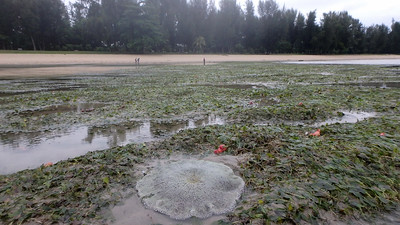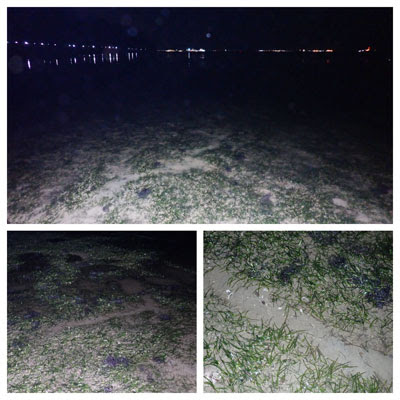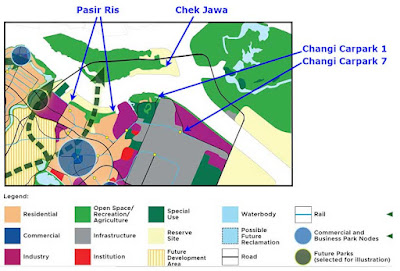Today, we saw puddles of oil on the high shore. The shore was also eeriely quiet, with no sea stars, and some stressed carpet anemones. But seagrasses were doing well, horse mussels seem gone and I saw what looks like dugong feeding trails. Meanwhile, some of the team checked out the Changi shore at the mouth of Changi Creek and saw more of what we normally see at Changi - sea stars, sea cucumbers. And no signs of oil spill.
On the high and mid-shore, we saw puddles of floating oil. Also some 'sudsy' patches near the oil puddles. There was still a strong smell of hydrocarbons, so the oil has not yet really broken down.
The most abundant animal on the shore were Haddon's carpet anemones - I saw many large ones. Most were alright, but about 5 were 'scrunched up' in a way that reminds me of stressed carpet anemones I saw during the 2007 mass deaths at Chek Jawa. There was also one that was very white but not bleaching.
There was a disturbing lack of sea stars today. Usually, this shore is dotted with many kinds of sea stars of various sizes. Today, I only saw one Painted sand star. Usually, there are lots of Thorny and Pink warty sea cucumbers. Today I saw only a few, Kelvin saw a few other kinds too. But there were still many Noble volutes of all sizes. We also saw small Ramose murex. There were many small crabs and hermit crabs. Window pane shells remain abundant, and many Fan shell clams were alive. Dead ones were homes for crabs! We also noticed many small rabbitfishes sheltering in pools left behind in the low tide.
As usual, Kelvin sees a lot more than I do. He came across a part of Marbled sea snake! Our team has seen this snake before at Changi (include in the montage is one seen here by Kok Sheng in 2013). Kelvin also found a second Ramose murex (smaller), other molluscs, a variety of fishes, also some different kinds of sea cucumbers. Alas, no sea stars.
I saw a few furrows that might be dugong feeding trails on the seaward side beyond the sandbars exposed at super low tide seaward. Dugong feeding trails are formed when dugongs chomp up seagrasses including their roots, leaving a shallow meandering furrow of about equal width and depth. We saw similar signs here on our last survey in Jun 2024, Jan 2024 and Jun 2023.
Seagrasses remain lush with dense cover of fresh green leaves without much epiphytes. For the first time since Aug 2018, I saw Noodle seagrass! Quite a large patch (about 2m) at the high shore. Needle seagrass (both broad and narrow leaves) remain the most abundant species. Also dense growths of Spoon seagrass (small and large leaves). There were scattered clumps of Fern seagrass. The patch of Smooth ribbon seagrass near the high shore seems similar to what I last saw on Jun 2024 remaining at about 10m long and about 4m wide. We didn't any patches of horse mussels! They were already much reduced in Jun 2024. We first noticed them during our Feb 2019 survey. Today, I only saw a few dead shells here and there. Where the patches used to be, there is now bare soft sand. We also saw some small Cake sand dollars.
Seems the shore is returning to being a sandy seagrassy area!
I went to check on the litter situation focusing on the short stretch of shore next to the Ferry Terminal which is outside Park jurisdiction and in the past was not cleaned regularly. Was surprised to see almost zero plastic litter!
Meanwhile, some of the team checked out the Changi shore at the mouth of Changi Creek. From photos shared by Marcus, so relieved to know they saw more sea stars there than we did at Carpark 7. They also said they did not see any signs of oil. Marcus saw not only Biscuit sea stars, but also a Knobbly sea star and a spiny sea star. Also the usual sea cucumbers, plus a Kanga nudibranch (quite commonly seen on our Northern shores). There was also an explosion of Hairy sea hares! Which squirt purple dye when they feel stressed.
Adriane saw an explosion of tiny Swimming anemones! This is sometimes observed in our northern seagrass meadows. There is also a small rocky shore and here, there were nicely formed sea fans and sponges. He also saw the variety of sea cucumbers and sea stars that is usually seen at Changi. As well as a small Ramose murex snail and some interesting fishes like the seagrass pipefish.
What is the fate of these shores?
There doesn't seem to be a change in 2013 plans to reclaim all of Pasir Ris, all of Changi from Carpark 1 to Carpark 7 and beyond, and reclaim Chek Jawa and Pulau Sekudu. These appear to remain in place in the Long-Term Plan Review. Including plans for a road link that starts at Pasir Ris, crosses to Pulau Ubin, right across Chek Jawa to Pulau Tekong, and back to the mainland at Changi East.
See Changi shores for yourself!
They are easy to get to, and enjoyed by many people. It remains rich in marine life. More details in "Changi - an easy intertidal adventure for the family".

Photos by Kelvin Yong
At Changi Creek shores
Photos by Marcus Ng
Adriane Lee
Others at this other Changi shore: Fiora Li













